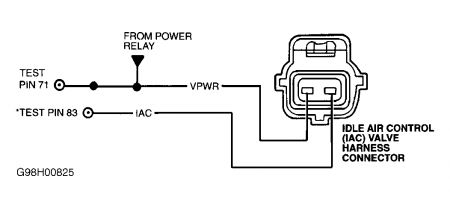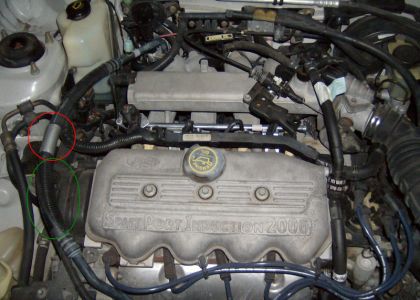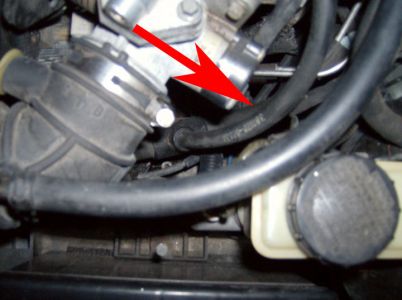
TESTS W/CODES (SOHC) -1998 Mercury Tracer GS
Page 1 of 5
Diagnostic Aids
Perform this test when instructed during QUICK TEST or if directed by other test procedures. This test is used to diagnose the following:
� � � Throttle linkage.
� � � Wiring harness circuits (IAC and VPWR).
� � � Faulty Idle Air Control (IAC) valve.
� � � Faulty throttle body.
� � � Faulty Powertrain Control Module (PCM).
Fig. 52: Identifying IAC Circuit & Connector Terminals
1) Check For DTCs
Retrieve and record all Continuous Memory DTCs. Perform KOER ON-DEMAND SELF-TEST . If DTC P0505, P1504 or P1507 is present, go to next step. If DTC P0505 or P1507 is not present, IAC system is okay and testing is complete. If symptom exists, go to TESTS W/O CODES - EEC-V article.
2) DTC P0505, P1504 & P1507
DTCs P0505 and P1504 indicate IAC system malfunction has been detected. DTC P1507 indicates that IAC system under speed fault has been detected. Possible causes are:
� � � IAC circuit open or shorted to PWR.
� � � VPWR circuit open.
� � � Contaminated IAC valve assembly.
� � � Damaged throttle body.
� � � Faulty IAC valve.
� � � Faulty PCM.
Turn ignition off. Disconnect IAC valve connector. Turn ignition on. Measure voltage between VPWR terminal at IAC valve wiring harness connector and battery ground terminal. If voltage is more than 10.5 volts, go to next step. If voltage is 10.5 volts or less, repair open in VPWR circuit.
3) Check IAC Valve Resistance
Turn ignition off. Connect DVOM positive lead to VPWR terminal at IAC valve. Connect DVOM negative lead to IAC terminal at IAC valve. If resistance is 6-13 ohms, go to next step. If resistance is not 6-13 ohms, replace IAC valve assembly.
4) Check IAC Valve Internal Short To Case
Turn ignition off. Measure resistance between each IAC valve terminal and IAC housing. If both resistance readings are more than 10,000 ohms, go to next step. If any resistance reading is 10,000 ohms or less, replace IAC valve assembly.
1/29/2009
TESTS W/CODES (SOHC) -1998 Mercury Tracer GS
Page 2 of 5
5) Check Air Inlet System
Turn ignition off. Remove air filter. Inspect air filter, MAF sensor and air inlet system for excessive dirt or contamination. Repair as necessary. If air inlet system is okay, go to next step.
6) Check For Vacuum Leaks
Start engine and allow to idle. Inspect air inlet system any of the following possible faults:
� � � Cracked or punctured air inlet tube.
� � � Loose inlet air tube or air cleaner housing.
� � � Loose or damaged throttle body.
� � � Contaminated or damaged IAC valve assembly.
� � � Faulty EGR valve or gasket.
� � � Faulty PCV valve or hose.
Check entire system for vacuum leaks. Repair as necessary. If no vacuum leaks are found, go to next step.
7) Check IAC Circuit Continuity
Turn ignition off. Disconnect PCM 104-pin connector. Inspect connector for loose, damaged or corroded terminals. Repair as necessary. Install Breakout Box (014-00950), leaving PCM disconnected. Measure resistance between breakout box test pin No. 83 (IAC) and IAC terminal at IAC valve wiring harness connector. If resistance is 5 ohms or more, repair open in IAC circuit. If resistance is less than 5 ohms, go to next step.
8) Check IAC Circuit For Short To Power
Turn ignition on. Measure voltage between test pin No. 83 (IAC) at breakout box and chassis ground. If voltage is one volt or more, repair short to power in IAC circuit. If voltage is less than one volt, go to next step.
9) Check IAC Circuit For Short To Ground
Turn ignition off. Disconnect scan tool from DLC. Measure resistance between test pin No. 83 (IAC) and test pins No. 51 and 103 (PWR GND) at breakout box. If resistance is more than 10,000 ohms, go to next step. If resistance is 10,000 ohms or less, repair short to ground in IAC circuit.
10) Check IAC Signal From PCM
Connect PCM to breakout box. Connect IAC valve to wiring harness connector. Connect DVOM between test pins No. 83 (IAC) and No. 51 (PWR GND) at breakout box. Start engine and slowly increase speed to 3000 RPM. If voltage is not 3.0-11.5, replace PCM. If voltage is 3.0-11.5 volts, proceed as follows:
� � � If Continuous Memory DTC P1504 or P1507 is present, go to step 30).
� � � If Continuous Memory DTC P1504 or P1507 is not present, check throttle body for damage.
1/29/2009
TESTS W/CODES (SOHC) -1998 Mercury Tracer GS
Page 3 of 5
Repair as necessary. If throttle body is okay, replace IAC valve.
NOTE: A break in step numbering sequence occurs at this point. Procedure skips from step 10) to step 20). No test procedures have been omitted.
20) DTC P1506
This DTC indicates IAC system has reached over speed malfunction. Possible causes are:
� � � IAC circuit short to ground.
� � � IAC assembly stuck open.
� � � Air intake leaks or restrictions.
� � � Damaged throttle body.
� � � Contaminated or damaged IAC valve assembly.
� � � Faulty Powertrain Control Module (PCM).
Start engine and allow to idle. Inspect air inlet system any of the following possible faults:
� � � Cracked or punctured air inlet tube.
� � � Loose inlet air tube or air cleaner housing.
� � � Loose or damaged throttle body.
� � � Contaminated or damaged IAC valve assembly.
� � � Faulty EGR valve or gasket.
� � � Faulty PCV valve or hose.
Check entire system for vacuum leaks. Repair as necessary. If no vacuum leaks are found, go to next step.
21) Check EVAP System
Turn ignition off. Disconnect hoses from EVAP canister purge valve. Connect a vacuum pump to carbon canister hose port. See Fig. 53 . Using vacuum pump, apply 16 in. Hg to port. If vacuum bleeds off within 20 seconds, replace EVAP canister purge valve. If vacuum holds, go to next step.
Fig. 53: Identifying EVAP Canister Purge Hose Ports
22) Check IAC Valve Function
Start engine and allow to idle. Ensure transmission is in Park or Neutral and engine is warmed to normal operating temperature. Disconnect IAC valve wiring harness connector. If engine speed drops, go to next step. If engine speed does not drop, check throttle body for damage. If throttle body is okay, replace IAC valve.
23) Check IAC Circuit For Short To Ground
Turn ignition off. Disconnect scan tool from DLC. Disconnect PCM 104-pin connector. Inspect connector for loose, damaged or corroded terminals. Repair as necessary. Install Breakout Box
1/29/2009
TESTS W/CODES (SOHC) -1998 Mercury Tracer GS
Page 4 of 5
(014-00950), leaving PCM disconnected. Measure resistance between test pin No. 83 (IAC) and test pins No. 51 and 103 (PWR GND) at breakout box. If both resistance readings are more than 10,000 ohms and idle speed is normal, go to step 30). If both resistance readings are more than 10,000 ohms and high idle speed is present, replace PCM. If resistance is 10,000 ohms or less, repair short to ground in IAC circuit.
NOTE: A break in step numbering sequence occurs at this point. Procedure skips from step 23) to step 25). No test procedures have been omitted.
25) DTC P1505: Check Inlet Air Supply
This DTC indicates IAC system has reached the adaptive learning limit. Possible causes are:
� � � Air intake leaks or restrictions.
� � � Throttle body linkage binding.
� � � Contaminated or damaged IAC valve assembly.
� � � Damaged throttle body.
Inspect air intake system for leaks. Repair as necessary. If air intake system is okay, go to next step.
26) Check Air Inlet System
Turn ignition off. Remove air filter. Inspect air filter, MAF sensor and air inlet system for excessive dirt or contamination. Repair as necessary. If air intake system is okay, go to next step.
27) Check Throttle Body & Linkage
Disconnect accelerator cable. Remove air cleaner tube from throttle body. Check cable and throttle body linkage for binding or interference. If faults are present, go to CIRCUIT TEST HU , step 3). If no faults are present, go to CIRCUIT TEST HU, step 8).
NOTE: A break in step numbering sequence occurs at this point. Procedure skips from step 27) to step 30). No test procedures have been omitted.
30) Check IAC System For Intermittent Open Or Short Circuit
Connect scan tool to DLC. Start engine and allow to idle. Ensure all accessories are off and engine is warmed to normal operating temperature. Using scan tool, select IAC and RPM PIDs from PID/DATA monitor menu. IAC duty cycle should be 20-45 percent. Observe IAC and RPM PIDs for indication of fault while performing the following:
� � � Wiggle and bend wiring harness starting at IAC valve and work toward PCM.
� � � Lightly tap on IAC valve to simulate road shock.
Fault will be indicated by sudden change in IAC PID or RPM PID value. If any faults are found, isolate fault and repair as necessary. If no faults are found, problem cannot be duplicated at this time. Go to CIRCUIT TEST Z .
Thursday, January 29th, 2009 AT 11:24 AM






